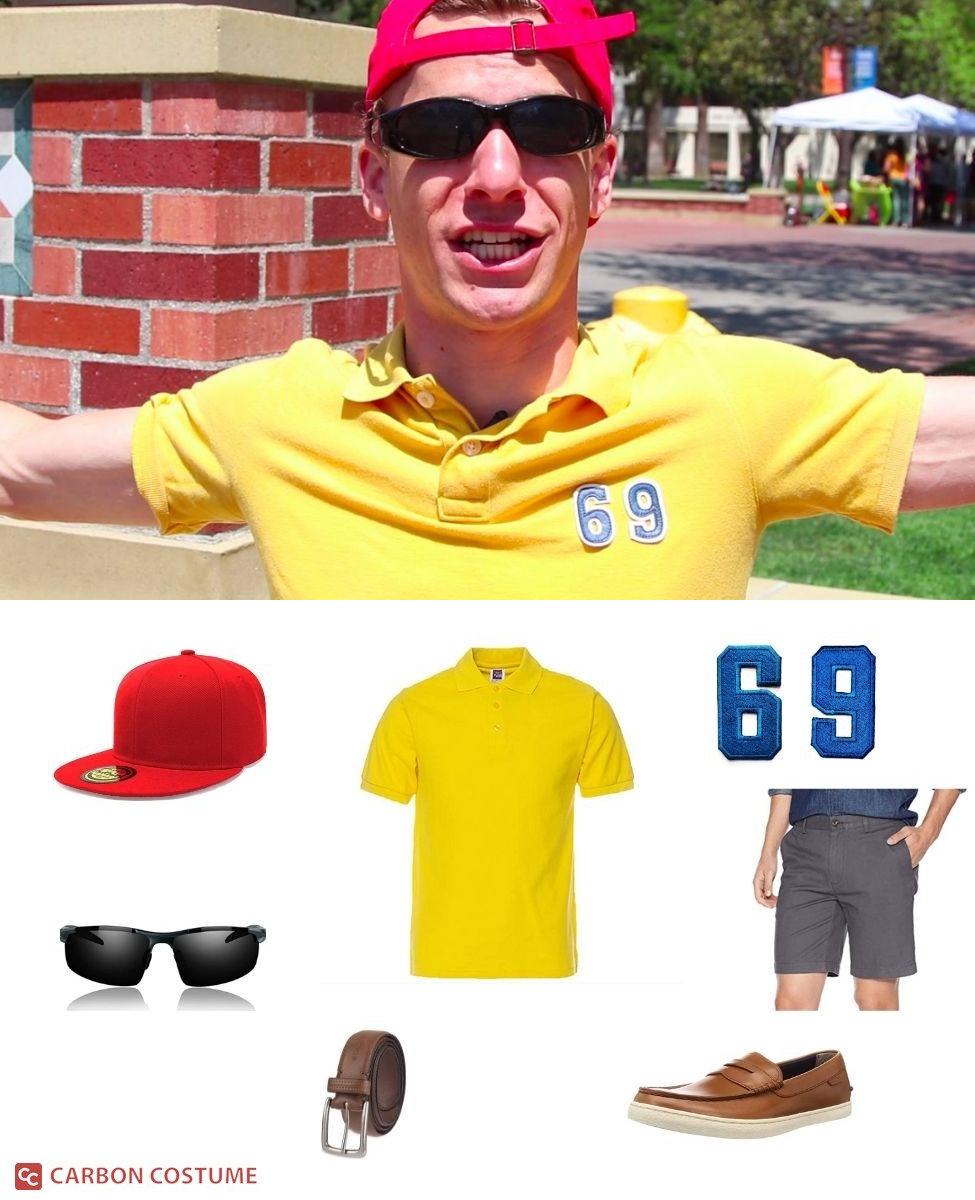Costume
Frat Boy Costume 101: The Ultimate Style Guide for Success
Frat boy costume in movies have undergone a notable evolution over the past few decades. Initially relegated to background roles and stereotypical depictions, frat boys have become more complex and empowered characters on the big screen. This shift reflects changing attitudes and a desire for more inclusive storytelling in Hollywood.
Plot and Script: Breaking the Stereotype

Frat boy costume: Moving Beyond Caricatures
In early frat boy portrayals, these characters tended to be one-dimensional, serving as little more than drunken comic relief. They were uniformly white, privileged partiers who cared more about alcohol and pranks than studies or self-improvement. While they helped set a scene of college debauchery, they lacked complexity and agency. However, in recent years, frat boy depictions have moved beyond exaggeration and into more thoughtful representations.
Modern frat boy characters grapple with real personal issues and face meaningful choices that impact the overall story. While they may still party and embrace certain carefree elements of frat life, they are rendered as complete human beings rather than caricatures. Nuanced backstories explore their motivations and vulnerabilities, making them far more relatable. Ultimately, fleshed out frat boy roles create space for them to grow and drive narrative development.
Subverting Expectations
In addition to added dimension, recent frat boy portrayals also consciously subvert viewer expectations. Rather than falling into familiar alpha male stereotypes, these characters often showcase untraditional or even countercultural traits.
For example, while past frat boys uniformly exuded hyper-masculine bravado, modern interpretations might embrace femininity or display atypical weakness and neuroticism. Similarly, whereas frat boys once came exclusively from white upper-crust backgrounds, new depictions showcase diverse perspectives and backgrounds. By challenging preconceived notions of what frat boys supposedly represent, contemporary cinematic portrayals are breaking new ground.
Direction and Character Development: A Shift in Perspective

Empathetic Direction
Past directors took a removed, judgmental stance toward frat boy characters, denying them empathy and falling back on unflattering stereotypes. However, modern directors take a more understanding approach, exploring the human side of these characters rather than just exploiting them for humor or shock value.
Through thoughtful cinematography and narrative choices, directors provide insight into the doubts, cares, and dreams of traditionally backgrounded frat boys. Close-ups capture vulnerable expressions, while plot events reveal formative experiences in their past. Overall, audiences are invited to emotionally connect with and root for the personal growth of characters long mired in simplistic typecasting. This shift toward compassionate, insider perspectives represents a seismic change.
Frat boy costume: Dynamic Character Arcs
Previously, frat boy characters remained essentially static throughout films – unchanged by plot events and solely present to enable raucous party scenes. Alternatively, today’s cinematic frat boys undergo meaningful internal and external transformations that drive larger story arcs.
Through revelatory experiences at college and beyond, they question and eventually shed their reckless personas, developing more serious perspectives on life. The personal development arc of the frat boy, once denied, is now essential to the central narrative. By film’s end, the audience feels invested in the final positive outcome realized by a formerly one-note comedic device.
Actors: Bringing Frat Boys to Life

Range and Nuance
Given reductive past roles, frat boy characters provided little room for actors to showcase their dramatic skills. However, contemporary parts offer greater depth and complexity. Through these meatier roles, talented actors demonstrate impressive range in bringing frat boys convincingly to life.
With razor-sharp comedic timing, they first establish their characters’ youthful follies and hunger for fun. Then, as the narrative unfolds, they reveal striking emotional range, expertly tracking their characters’ gradual awakening into mature self-awareness. Where frat boy roles once highlighted exaggerated juvenile excess at the expense of humanity, actors now paint a complete, sympathetic portrait.
Frat boy costume: Prestigious Portrayals
While frat boy roles were once throwaway parts for unknown tentative actors, A-list stars now proudly take on these more sophisticated parts. Drawn to the new dramatic complexity and substance of the characters, prominent lead actors sink their teeth into all facets of the role – comedic, dramatic, physical, and emotional.
Their commitment demonstrates that playing frat boys in serious contemporary films is no longer considered professional slumming. These prestigious portrayals in turn help further legitimize evolved cinematic frat boy depictions in the eyes of mass audiences. What was once a disposable comedic device is now a vehicle for actors to gain critical appreciation.
Sound and Music Effects: Enhancing the Frat Boy Experience
Nuanced Sonic Atmospheres
Early frat boy movies leaned heavily on loud party anthems and wacky sound effects to underscore wild hijinks. However, modern soundtracks add nuanced layers that immerse audiences within the full frat boy experience.
Moments of quiet reflection feature gentle indie instrumentation as protagonists ponder their identities and choices. Meanwhile, tense conversations with parents might incorporate spare piano notes highlighting
Frat boy costume have long been a staple of college movies, often portraying these characters in a stereotypical or exaggerated manner for comedic effect. However, in recent years, there has been a shift towards more nuanced and positive frat boy representations that move beyond outdated stereotypes. Let’s examine some of the key evolutions in how frat boy costume have been utilized in movies over the years.
Plot and Script: Breaking the Stereotype
Early college movies tended to rely on frat boys as minor characters or one-note jokes, leaning heavily on their party-boy reputations for easy laughs. Their costumes reinforced these stereotypes, with varsity jackets, backwards baseball caps, and beer-branded tanks setting a tone of reckless immaturity. However, as the genre has matured, more nuanced frat boy characters have emerged in lead and supporting roles.
Frat boy costume: Moving Beyond Stereotypes
More recent scripts paint frat boys as complex characters with hopes, dreams, and challenges like anyone else. Their story arcs delve beyond surface-level hijinks to explore meaningful personal growth. This shift is reflected in more thoughtful costume choices that retain authentic frat style while avoiding shallow stereotypes.
Adding Dimension Through Costume
Subtler costume details quietly reinforce that frat boys are multifaceted people. A character’s financial aid pin conveys his need for scholarship money. His faithful wearing of a religious pendant hints at personal values. Costumes support character depth.
Driving More Complex Narratives
As scripts move beyond stereotypes, costumes help drive fresh narratives. A frat boy’s quest to balance his studies and rowing team duties play out through his chaotic mix of preppy class clothes and athletic gear. His costumes support this nuanced story.
Direction and Character Development: A Shift in Perspective
Directorial choices greatly impact how frat boy characters come across on screen. Many earlier films presented frat life from an outsider’s exaggerated perspective for maximum comedy. But as frat boys have gained more prominent film roles, directors have shifted to add nuance, empathy, and dimensionality.
Empowering Frat Boy Perspectives
More movies now show events from the frat boys’ point of view. Audiences get insight into their world, motivations, and pressures. Directors use costume to quietly reinforce these perspectives, dressing frat boys in a realistic, everyday manner as protagonists.
Building Empathy Through Costume
Directors leverage costume to encourage empathy. As a frat boy stresses over an upcoming test, his disheveled state in sweats and a hoodie makes his anxiety relatable. Authentic costuming grounds his experience.
Signaling Growth and Change
A frat boy’s personal growth can be underscored through evolving costumes. As he matures, his sloppy party clothes give way to more put-together outfits signaling his newfound maturity. Costume evolution mirrors his inner journey.
Actors: Bringing Frat Boys to Life

Skilled actors have proven essential in taking frat boy characters beyond stereotypes to create authentic, compelling individuals. Their nuanced acting and costuming choices add layers often missing in earlier two-dimensional portrayals.
Finding Depth and Humanity
Talented actors tap into a frat boy’s hopes and fears to find the deeper humanity and emotions beneath the surface. They collaborate on costumes that feel truly lived-in to support these authentic characters.
Crafting Distinct Identities
Beyond generic frat style, actors work with costume designers to create distinct identities. One frat boy’s preppy polos and dockers reflect his country club background. Another shows his laidback vibe through board shorts and tanks. Costumes build unique personalities.
Inhabiting Roles Convincingly
Inhabiting a character extends to how he physically wears his costumes. An actor may take care to wear his baseball cap slightly askew or leave shirts carelessly untucked. Such choices reinforce an authentic frat boy energy and grounded identity.
Sound and Music Effects: Enhancing the Frat Boy Experience

Soundtracks and audio cues play an equally important role in shaping how frat boy characters are perceived. Music is often used to set their tone, from chaotic parties to quieter moments of reflection.
Setting Tone Through Music
The soundtrack establishes context and mood. Hard rocking party anthems underscore wild frat parties. But a gentle acoustic song plays as a frat boy shares an intimate moment with a love interest. Music guides audience perspective.
Reinforcing Internal Experiences
Sound effects provide windows into frat boys’ internal experiences. Heavy breathing conveys anxiety before a big game. Crickets echoing through an empty house reinforce loneliness. Audio elevates emotional stakes.
Building Authentic Atmosphere
Realistic sound helps build believable frat boy environments. Clinking beers, laughter, and loud banter create authentic party ambience. A clock ticking quietly in an empty fraternity house underscores a contemplative mood. Audio makes settings feel tangible.
Expert Rating: Critical Acclaim and Audience Reception
As frat boy portrayals have evolved, responses from professional critics and everyday audiences have shifted as well. While crass stereotypes were once accepted uncritically, modern viewers appreciate increased authenticity, empathy and character depth.
Evolving Critical Standards
Critics once praised frat boy movies solely for raunchy comedy. Now reviews highlight nuanced acting and storytelling with commentary on refreshed representations. Critics expect more thoughtful frat boy characters.
Audience Demand for Authenticity
Mainstream audiences have also grown savvier. While reductive frat stereotypes were once tolerated, viewers now reject caricatures. Audiences better identify with relatable, humanized frat boy experiences.
Appreciation for Dimensionality
Once satisfied by generically humorous frat boys, everyday viewers now enthusiastically respond to performances reflecting realistic personality. Fans connect with frat boys portrayed as complete human beings.
Box Office Performance: From Flop to Success
The financial success of frat boy movies mirrors their evolution. Once reliant on superficial raunch, modern movies with dimensional frat boy portrayals have struck box office gold thanks to compelling stories and universal appeal.
One-Note Comedies Fall Flat
Earlier frat comedies with derivative party antics and stereotypes fizzled out fast. Reliance on cliches failed to attract substantial, lasting audiences beyond college kids seeking cheap laughs.
Crossover Appeal Through Authenticity
As scripts introduced more humanized leads, grounded direction and nuanced acting, frat movies gained mainstream traction. Relatable stories now draw diverse demographics beyond the college crowd.
Mainstream Success of Evolved Portrayals
Major studios have taken notice, heavily backing franchises featuring dimensional frat heroes. Empathetic everyman portrayals have achieved record box office earnings. Evolved frat boys mean big money.
Video
Conclusion
Elevate your costume game with Lavafury’s Frat Boy costume. Stand out at parties, events, and gatherings with this timeless and iconic ensemble that exudes the energy of fraternity life. Trust Lavafury to deliver a costume that blends quality, authenticity, and a touch of collegiate flair. Make a lasting impression with Lavafury Frat Boy costume – the ultimate choice for those who seek classic and cool in their costume collection.


